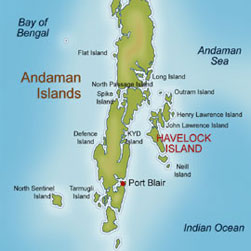- phone: (+91)9933215764
- mail: [email protected]

Andaman and Nicobar
The Andaman and Nicobar Islands were shrouded in mystery for centuries because of their inaccessibility. These are the paragon of beauty and present a landscape full with scenic and picturesque extravaganza. These islands shimmer like emeralds in the Bay of Bengal. The dense forest which cover these islands and the innumerable exotic flowers and birds create a highly poetic and romantic atmosphere. "Here the white beaches on the edge of a meandering coastline have palm trees that sway to the rhythm of the Sea. The beat of tribal drums haunt the stillness and technicolor fish steer their way through crystal clear water." The scenic beauty of Andaman & Nicobar Islands, would create a sense of dissatisfaction and the human mind would rebel against "the whole mass of the motley facts of life".
The Andaman & Nicobar are a group of picturesque Islands, big and small, inhabited and uninhabited, a total of 572 islands, islets and rocks lying in the South Eastern Part of the Bay of Bengal.They lie along an arc in long and narrow broken chain, approximately North-South over a distance nearly 800 kms. It is logical to presume a former land connection form Cape Negris at South part of Burma to Achin Head (Cape Pedro) in Andalas (Sumatra). The flora and fauna of these islands, however, indicate that this land connection if it existed, should have been prior to the development of their present life form.

The History
A clear history of the Andaman & Nicobar Islands can be had only from a British Survey of these islands conducted in 1777. The Andaman & Nicobar Islands remained the abode of the Negritos and the Mongoloids respectively, who occupied the Islands for centuries. These islands remained secluded from the mainland till the end of the 18th Century when people from the outside world first arrived. In the Second Century, the Andaman and Nicobar Islands were located in the maps prepared by the great Greek astronomer, mathematician and geographer, Claudius Ptolemaeus, which possibly is the earliest reference to these islands. The early history of Nicobar is not well known although these islands were familiar to traders in ancient times, the islands being situated close to the trade route to the Far East. Though little is known about Portuguese activities in these islands, it is evident that the Portuguese missionaries started preaching Christianity among the islanders. The Nicobarese language also reflects a few Portuguese words.
book now
The British Regime
A clear history of the Andaman & Nicobar Islands can be had only from a British Survey of these islands conducted in 1777. The Andaman & Nicobar Islands remained the abode of the Negritos and the Mongoloids respectively, who occupied the Islands for centuries. These islands remained secluded from the mainland till the end of the 18th Century when people from the outside world first arrived. In the Second Century, the Andaman and Nicobar Islands were located in the maps prepared by the great Greek astronomer, mathematician and geographer, Claudius Ptolemaeus, which possibly is the earliest reference to these islands. The early history of Nicobar is not well known although these islands were familiar to traders in ancient times, the islands being situated close to the trade route to the Far East. Though little is known about Portuguese activities in these islands, it is evident that the Portuguese missionaries started preaching Christianity among the islanders. The Nicobarese language also reflects a few Portuguese words.
book now
The Japanese Regime
World War II brought another series of changes in the life of the Andamans. During the War, the Japanese occupied Andamans on March 21, 1942 and kept the region under their effective control till October 8,1945 . Initially the Japanese behaved cordially towards the locals, but became harsh and suspicious after instances came to their notice of some locals maintaining contacts with the British. As a result a large number of innocent people were killed. One such place where the massacre occured is Humfreygunj. But one good result of the Japanese occupation was making the Andaman Tourism self-sufficient, at least in food production. The naval blockade created an acute food crisis and the Japanese compelled the local people to bring more land under cultivation. They also constructed roads. Netaji Subash Chandra Bose arrived in Port Blair on December 29, 1943 and was given a ceremonial welcome. He hoisted the National Flag at Port Blair on 30th Dec. 1943 for the first time during the British regime in India . On October 8, 1945 , the Japanese surrendered to the South East Asia Command at Port Blair. The Government quickly restored normalcy in the area and started rehabilitation work.
Port Blair, the capital City of Andaman & Nicobar Islands Port Blair is the capital of the Andaman and Nicobar Islands, a union territory of India. It lies on the east coast of South Andaman Island and is the main access to every part of Andaman & Nicobar Islands. Port Blair is a Headquarter of Andaman & Nicobar Andaman and Nicobar Administration.
newsletter subscription
Sign up to our newsletter to recive directly on your email our news & latest offers:
- Go into the monthly draw to win a $500 travel voucher when signing up with us.
- A special present from us on your birthday.
- Access to all the best competitions as they launch.

